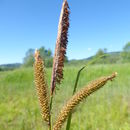Comments
provided by eFloras
A widely distributed, variable species, Carex barbarae is best identified using material with well-developed perigynia. Carex barbarae shares distinctive characteristics with C. obnupta, particularly the sessile, pendent, basally acuminate spikes, the leathery leaves, and the inflated, leathery, glabrous perigynia. Carex barbarae differs in having the scales awned and scabrous at the apex, and the perigynia faintly veined and dull brown, with a scabrous, firm, bidentate beak, all of which are similar to those of C. nebrascensis. Mature fruiting plants of C. barbarae have rarely been collected, suggesting that the species is largely sterile. The relationships among these three species merit investigation because the morphology and sterility of C. barbarae suggest that it may have a hybrid origin.
- license
- cc-by-nc-sa-3.0
- copyright
- Missouri Botanical Garden, 4344 Shaw Boulevard, St. Louis, MO, 63110 USA
Description
provided by eFloras
Plants not cespitose. Culms obtusely angled, 30–110 cm, glabrous. Leaves: basal sheaths brown; sheaths of proximal leaves scabrous, fronts with red-brown spots or uniformly red-brown, prominently ladder-fibrillose, apex U-shaped, red-brown; blades hypostomic, 4–9 mm wide, coriaceous, papillose abaxially. Inflorescences: proximal bract longer than inflorescence, 3–8 mm wide. Spikes erect, the proximal pendent, sessile or pedunculate; staminate 2–3; pistillate 4–6; the proximal pistillate spike 3–10 cm × 5–6 mm, base attenuate. Pistillate scales red-brown, longer than perigynia, apex acute, scabrous, awned, awn to 2 mm. Perigynia divergent, dark pale brown with red-brown spots on apical 1/2, faintly 3–5-veined on each face, somewhat inflated, loosely enclosing achenes, ellipsoid or obovoid, 3–4 × 2.2–2.5 mm, leathery, dull, apex rounded or obtuse, glabrous; beak red-brown, 0.5 mm, bidentate, orifice scabrous. Achenes not constricted, dull.
- license
- cc-by-nc-sa-3.0
- copyright
- Missouri Botanical Garden, 4344 Shaw Boulevard, St. Louis, MO, 63110 USA
Habitat
provided by eFloras
Wet meadows, fields, stream banks; 0–1000m.
- license
- cc-by-nc-sa-3.0
- copyright
- Missouri Botanical Garden, 4344 Shaw Boulevard, St. Louis, MO, 63110 USA
Comprehensive Description
provided by North American Flora
Carex barbarae Dewey, in Torr. Bot. Mex. Bound. Surv
231. 1859.
Carex laciniala Boott, (Benth. PI. Hartw. 341, name only, 1857.) 111. Carex 175. pi. 594. 1867.
(Type from banks of the Sacramento, California.) "Carex Prescottiana Boott" Olney, in S. Wats. Bot. King's Expl. 369. 1871. Carex Wilkesii Torr. U. S. Expl. Exp. 17: 477. pi. 17. 1874. (Type from banks of the Sacramento,
California.) Carex lacunarum Holm, Am. Jour. Sci. IV. 17: 303. /. 12, 13, 316. 1904. (Type from Sebastopol,
California.) Carex magnifica var. lacunarum Kiikenth. in Engler, Pflanzenreich 4-°: 366. 1909. (Based on C.
lacunarum Holm.) "Carex nudata var. anomala L. H. Bailey" Kiikenth. in Engler, Pflanzenreich 4 ;o : 377. 1909. (As
to California specimens.)
Densely cespitose and stoloniferous, the stolons long, horizontal, stout, dull-brownish> scaly, the culms 3-10 dm. high, stout at base, slender above but stiff, usually more or less exceeding the leaves, sharply triangular and smooth or roughened above, papillate, purplishred-tinged at base, phyllopodic, the dried-up leaves of the previous year conspicuous; sterile shoots aphyllopodic, their lower sheaths breaking and filamentose ; leaves with well developed blades 7-12 to a fertile culm, usually clustered towards the base, not septate-nodulose, the blades thick, papillate, light-green or glaucous-green, flat with revolute margins above, channeled and strongly keeled towards the base, usually 2-5 dm. long, 3.5-9 mm. wide, serrulate on the margins, very long-attenuate, the upper the longer, the lower of the flowering year much reduced, the sheaths breaking and becoming filamentose; sheaths rounded and short-hispidulous dorsally, dark-purplish-tinged ventrally, the ligule as long as wide to much longer than wide; staminate spikes 1 or 2, long-linear, the upper 3-6 cm. long, 4 mm. wide, the lower usually shorter, the scales varying from oblong-obovate to oblanceolate and from obtuse to rough-awned, reddish-brown with lighter midrib and hyaline margins; pistillate spikes 2-5, the upper often staminate at apex, erect, more or less strongly separate, the upper sessile or nearly so, the lower short-peduncled, or sometimes rather long-peduncled, oblong-cylindric or linear-cylindric, 2.5-8 cm. long, 5-8 mm. wide, densely flowered, little if at all attenuate at base, containing 50-200 ascending or in age spreading perigynia in several to many rows; lowest bract leaf-like, from shorter than to exceeding culm, sheathless; upper bracts reduced, the auricles often dark-tinged; scales ovate or ovate-lanceolate or lanceolate, mostly roughcuspidate or rough-awned, some occasionally merely acute, much narrower and from slightly or rarely much shorter to considerably longer than the perigynia, reddish-purple with lighter 3-nerved center and very narrow hyaline margins; perigynia unequally biconvex, flattened, oval-orbicular to oblong-obovate, 3-4.5 mm. long, 2-2.5 mm. wide, 2-ribbed (the marginal) and from strongly to obscurely several-nerved on both faces, submembranaceous, puncticulate, straw-colored, at length dull-brownish, red-dotted, rounded and stipitate at base, rounded above, sometimes slightly serrulate above, abruptly short-beaked, the beak sharply bidentate, 0.5 mm. long, the teeth hispidulous within; achenes lenticular, obovate-suborbicular, small, 1.75 mm. long; 1.25 mm. wide, loosely enveloped in lower half of perigynium-body, blackish, substipitate, not constricted in the middle, abruptly short-apiculate, jointed with the straight, rather short, slender style; stigmas 2, rather long. Type locality: "Banks of streams, Santa Barbara, California" (Parry).
Distribution: From southern Oregon southward through California west of the Sierra Nevada mountains, but in the canyons in the foot hills extending as far south as San Bernardino. One of the most characteristic Calif ornian species. (Specimens examined showing range as given.)
- bibliographic citation
- Kenneth Kent Mackenzie. 1935. (POALES); CYPERACEAE; CARICEAE. North American flora. vol 18(7). New York Botanical Garden, New York, NY

